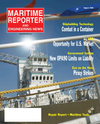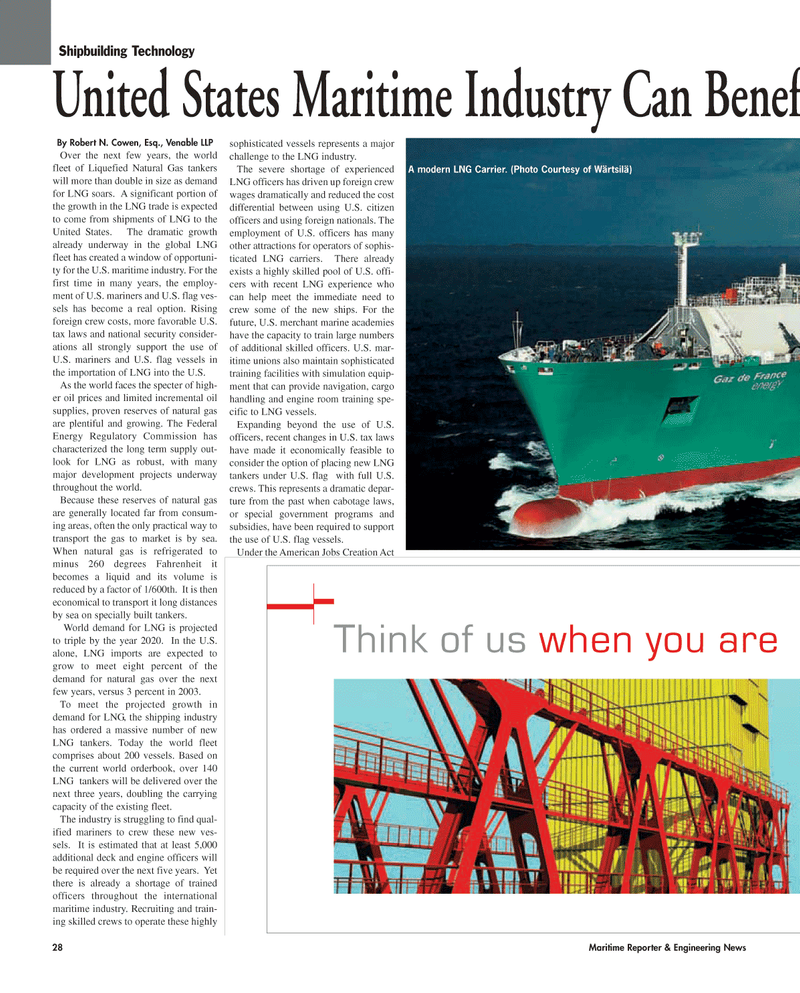
Page 28: of Maritime Reporter Magazine (August 2006)
AWO Edition: Inland & Offshore Waterways
Read this page in Pdf, Flash or Html5 edition of August 2006 Maritime Reporter Magazine
By Robert N. Cowen, Esq., Venable LLP
Over the next few years, the world fleet of Liquefied Natural Gas tankers will more than double in size as demand for LNG soars. A significant portion of the growth in the LNG trade is expected to come from shipments of LNG to the
United States. The dramatic growth already underway in the global LNG fleet has created a window of opportuni- ty for the U.S. maritime industry. For the first time in many years, the employ- ment of U.S. mariners and U.S. flag ves- sels has become a real option. Rising foreign crew costs, more favorable U.S. tax laws and national security consider- ations all strongly support the use of
U.S. mariners and U.S. flag vessels in the importation of LNG into the U.S.
As the world faces the specter of high- er oil prices and limited incremental oil supplies, proven reserves of natural gas are plentiful and growing. The Federal
Energy Regulatory Commission has characterized the long term supply out- look for LNG as robust, with many major development projects underway throughout the world.
Because these reserves of natural gas are generally located far from consum- ing areas, often the only practical way to transport the gas to market is by sea.
When natural gas is refrigerated to minus 260 degrees Fahrenheit it becomes a liquid and its volume is reduced by a factor of 1/600th. It is then economical to transport it long distances by sea on specially built tankers.
World demand for LNG is projected to triple by the year 2020. In the U.S. alone, LNG imports are expected to grow to meet eight percent of the demand for natural gas over the next few years, versus 3 percent in 2003.
To meet the projected growth in demand for LNG, the shipping industry has ordered a massive number of new
LNG tankers. Today the world fleet comprises about 200 vessels. Based on the current world orderbook, over 140
LNG tankers will be delivered over the next three years, doubling the carrying capacity of the existing fleet.
The industry is struggling to find qual- ified mariners to crew these new ves- sels. It is estimated that at least 5,000 additional deck and engine officers will be required over the next five years. Yet there is already a shortage of trained officers throughout the international maritime industry. Recruiting and train- ing skilled crews to operate these highly sophisticated vessels represents a major challenge to the LNG industry.
The severe shortage of experienced
LNG officers has driven up foreign crew wages dramatically and reduced the cost differential between using U.S. citizen officers and using foreign nationals. The employment of U.S. officers has many other attractions for operators of sophis- ticated LNG carriers. There already exists a highly skilled pool of U.S. offi- cers with recent LNG experience who can help meet the immediate need to crew some of the new ships. For the future, U.S. merchant marine academies have the capacity to train large numbers of additional skilled officers. U.S. mar- itime unions also maintain sophisticated training facilities with simulation equip- ment that can provide navigation, cargo handling and engine room training spe- cific to LNG vessels.
Expanding beyond the use of U.S. officers, recent changes in U.S. tax laws have made it economically feasible to consider the option of placing new LNG tankers under U.S. flag with full U.S. crews. This represents a dramatic depar- ture from the past when cabotage laws, or special government programs and subsidies, have been required to support the use of U.S. flag vessels.
Under the American Jobs Creation Act 28 Maritime Reporter & Engineering News
Shipbuilding Technology
A modern LNG Carrier. (Photo Courtesy of Wärtsilä)
United States Maritime Industry Can Benefit
Think of us when you are l
MR AUGUST2006 #4 (25-32).qxd 8/2/2006 5:44 PM Page 28

 27
27

 29
29
